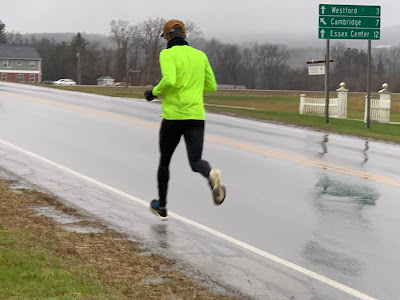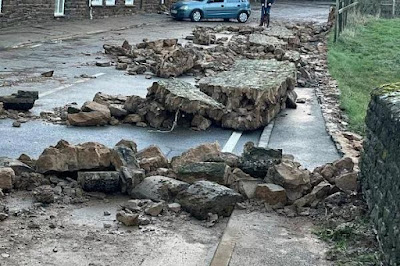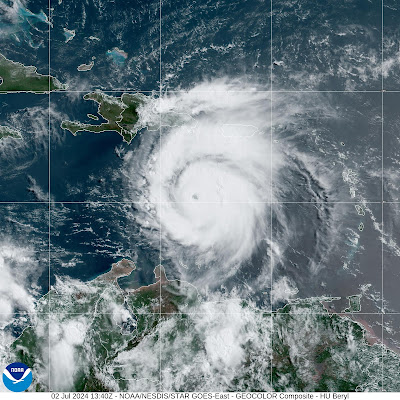 |
Update snowfall forecast map from the National
Weather Service office in South Burlington. Click
on it to make it bigger and easier to see. Compared
to earlier forecast, the areas expected more
than six inches snow (yellow and orange) have
greatly expanded in the past 24 hours.
Pretty much all of Vermont except maybe the
immediate shores of Lake Champlain are now
expecting accumulation. |
Our big Thankgiving snowstorm is here, and will be ramping up through the day.
Updated forecasts continue to increase total snow amounts, and expand the areas that will receive a decent amount of snow. That's especially true here in Vermont.
The winter storm warnings extend through much of central and eastern New York, much of Vermont (details to follow), most of New Hampshire and all but coastal Maine.
This will easily be the biggest Thanksgiving snowstorm for many of us since 1971.
If you're reading this Thanksgiving morning, things might not seem to intense yet, but it will ramp keep ramping up into this afternoon.
I don't recommend travel through northern New York and the northern half of New England through today and into this evening. Not getting along with the family and want to leave? Well, buckle up, buttercup, you're stuck with them for the day.
If you live in areas where the snow is likely to be heaviest, charge your devices this morning. You might lose electricity.
MORNING SETUP AND CHANGES
Snow and rain had overspread most of Vermont as of 8 a.m. but was falling lightly and has yet to cause many problems. Warmer valleys are having a cold rain, as expected, but you don't have to go up much in elevation to hit snow.
Conditions were already starting to go down hill. As of 8 a.m., traffic cameras were showing Interstates 89 and 91 and state highways were already starting to get snow covered in areas outside the Champlain Valley and lowest elevations in southwest Vermont.
Here are some changes to the forecast that hint at perhaps a bigger storm that we were thinking a couple days ago:
 |
Traffic cam image from Route 9 in Searsburg,
Vermont shows treacherous conditions already
at 9 a.m. Roads statewide will continue to
get worse through the day. |
1. The storm has a boatload of moisture, more than first anticipated. That would increase the amount of precipitation and snowfall accumulations.
It would also bump more snow northwestward in Vermont than first thought. So this snow will cover more real estate than the earlier thinking.
2. The heavier precipitation means that it will cool the atmosphere a little more efficiently.
That means some places like the Champlain Valley - especially away from the immediate lake shore - will have some accumulating snow after all. Not as much as the rest of the state, but we're looking at a whiter look.
As things started, I found it interesting that it was already snowing in low elevation downtown Brattleboro. Traffic cams along Route 4 in low elevation West Rutland showed rain at 8 a.m. but a flip to snow by 9 a.m. It was still rain in Burlington and St. Albans, and we'll see how that goes through the day. It could change to snow earlier than forecast??
The Warnings, Alerts And Accumulations
The winter storm warning has been expanded in Vermont to cover a good chunk of the Northeast Kingdom. Most of the eastern half of Vermont is now under the warning and can expect four to nine inches of new snow, with higher amounts in the mountains and in southern parts of the state.
Some high elevations in southern and central Vermont could get a foot of snow out of this. The areas in this zone that are now expected to get more than six inches of snow has roughly doubled since yesterday's forecasts.
 |
A classic bridges freeze before road scenario at 9:15
this morning at Interstate 89 exit 10 in Waterbury,
Vermont. Most of the roadway is a little slushy,
but note the thicker snow and ice on the exit ramp bridge. |
The winter weather advisory north and west of the winter storm zone was expanded to Franklin County. So now only Grand Isle County in Vermont is not under any weather alerts.
There might not be much snow in the northern Champlain Valley with expected accumulations of one to four inches. But given it's Thankgiving and the first true wintry spell of the season, the National Weather Service office in Burlington figures it's worth the precautions.
What To Expect/What To Do
The storm will peak this afternoon, with snowfall rates in southern Vermont probably hitting more than one inch per hour at times. That's too fast to keep up with the snow plowing, so travel will be abysmal.
This will be a wet snow, which tends to compact into ice under the pressure from tires in traffic. So it won't be just snow on the roads. I expect local road closures at times, especially in hilly areas, due to stuck cars and trucks, slide offs, and trees and branches falling onto road ways.
In northwestern Vermont, the snow won't be as heavy, and will come later. It might trick you a bit. You might notice roads aren't so bad at midafternoon and you'll head out, only to see the pavement get covered up with snow and black ice pretty quickly as temperatures fall later today.
I'm not sure of the timing of when snow will hit in the Champlain Valley. That area is a wild card with this storm, and probably the hardest area to forecast with this storm. If the atmosphere cools just a degree or two more than expected late this morning, there could be more snow there than forecast. On the other hand, a degree or two warmer than expected, and we revert to just mostly rain.
Power outages unfortunately look inevitable this afternoon and evening in the heavy snow areas. This stuff is wet cement type schmutz, which will click to trees and power lines and knock some of them down. Unfortunate timing, since a power outage would certainly screw up a turkey feast.
As of 9 a.m., there was already one small power outage, affecting 37 homes in high elevation Stamford, on the Massachusetts border. By this afternoon, hundreds or even thousands of homes and businesses could be without electricity.
I also want to give a huge shout out here to the road crews who will will be struggling to clear the roads and the utility workers who will be restoring power. Instead of spending time with their families this holiday, they will be toiling away in miserable weather to keep you safe.
The storm will wind down during the first half of tonight, but iffy, icy roads will linger as temperatures drop. I'd wait until tomorrow to get in the car and drive anywhere.
And watch it while shoveling the snow. This is heart attack stuff. Get your strapping teenage boys and athletic teenage girls in your families to shovel the driveway. Your family and local emergency room will thank you.
Storm Benefits
Yeah, I get it, the storm was inconveniently timed for some of us and the road conditions are a pain. But this storm is giving Vermont a huge benefit, too.
The unofficial start to the ski season is Thanksgiving weekend, and our resorts have been dealing with a lack of snow and often weather that's too warm for making snow.
This one storm fixes a lot of those problems. The storm is laying down a nice base, which will stick around for awhile since it's supposed to stay cold for days or weeks after this storm. The publicity this snowstorm is giving ski areas is probably better than a $1 million ad campaign. Day trippers will probably be talked into coming to northern New England to enjoy the best Thanksgiving week conditions in years.
This story is also timed beautifully just ahead of a big World Cup skiing event at Killington, set to start tomorrow.
This storm is also very wet, and is focusing its fury on the part of Vermont worst affected by this autumn's drought, which by the way continues full force as of earlier this week. Much of southern Vermont will get the equivalent of an inch or more of rain out of this storm. Some of this moisture will immediately soak into the ground, while more will do so when the snow eventually melts.
This snowstorm won't erase the drought, but it will put a needed dent into it.
So, there's definitely bright sides to this storm, so enjoy!


























